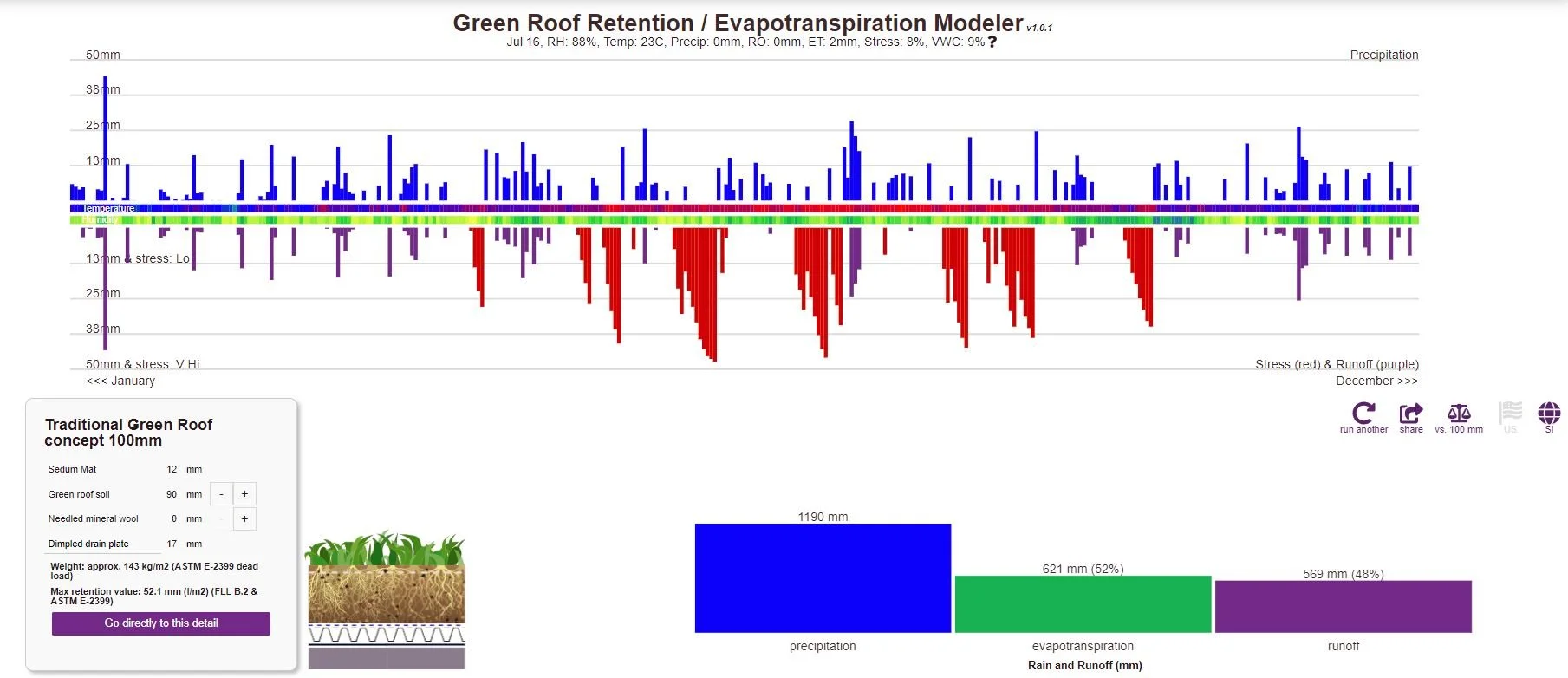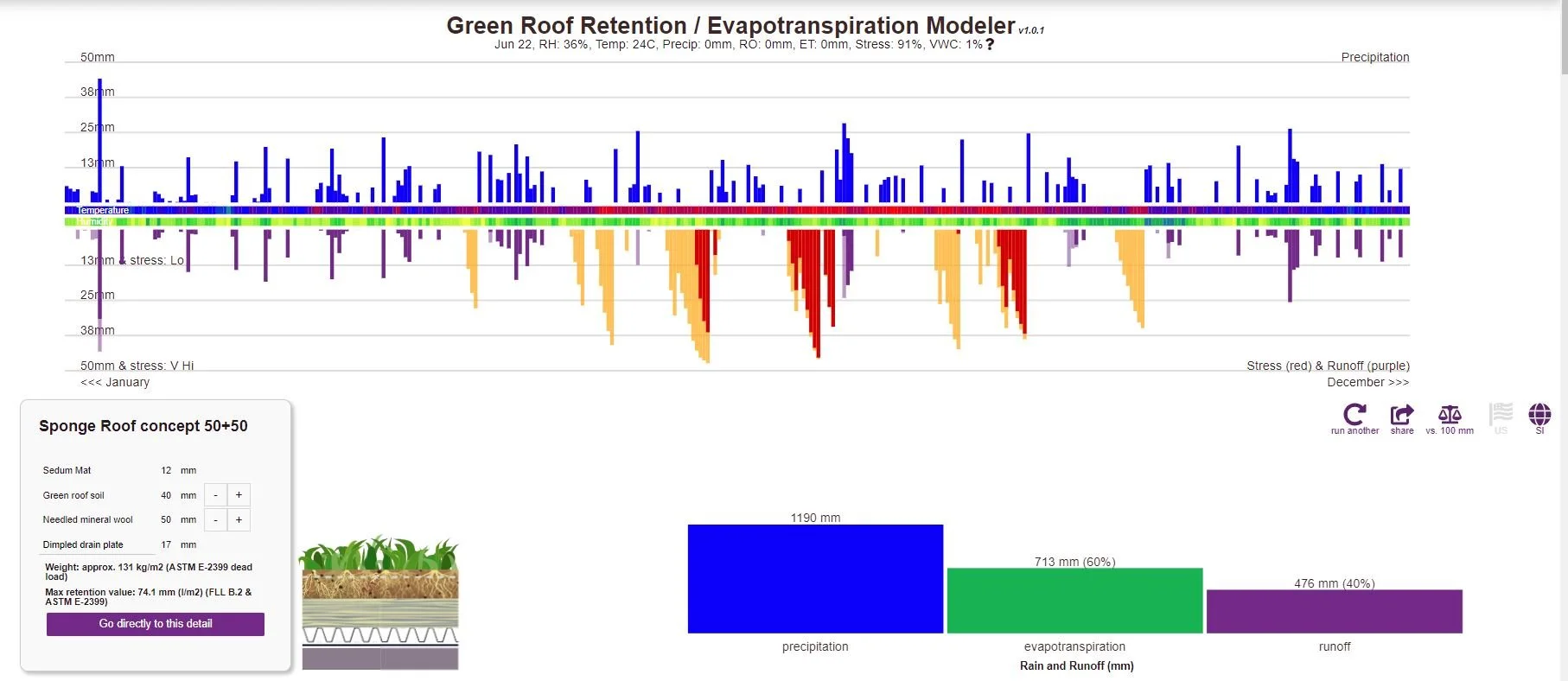Why Evapotranspiration and Retention Volumes are the Same
Advertisement
Evapotranspiration & Retention
How much water can a green roof retain? Well, it depends on how wet it already is. If the profile is already generating runoff, it will likely not retain any additional water. If the roof is dry, it has a lot of capacity to store water in the substrate.
The rate at which the roof regains retention capacity is determined by the combined processes of evaporation and transpiration – the evapotranspiration process. Since the plants mainly determine this process on the roof, it is possible to accurately determine its retention capacity using annual evapotranspiration rates. Hence, retention and evapotranspiration represent the same volumes.
Retention capacity is not determined by soaking a profile in water as per ASTM E-2399. This test will determine the maximum load of the roof (which it does well), but it was never intended to measure retention as it simply does not do that. The precipitation distributions, gravitational water flow, and plant transpiration and evaporation processes render ASTM E-2399 void as a measure for retention.
Model outputs for NYC without mineral wool. Image: Purple Roof
Model outputs for NYC without mineral wool. Image: Purple-Roof
Evapotranspiration model output for NYC for an extensive sedum green roof. The profile thickness is the same for both profiles, but the bottom one includes 50mm toxin-free mineral wool instead of just soil substrate. The red bars denote high plant stress. Annual evapotranspiration is increased from 52% in the soil substrate only example to 60% in the bottom example (with mineral wool). This increased evapotranspiration translates into a significant extra cooling effect over the year, as well as higher plant health and less water in the canalization. The purple bars denote large storm events that the roofs cannot capture. To manage those storms, detention capacity must be added to the roof. Get a more in-depth explanation of the output parameters and the equations used.
Advertisement
The Importance of Considering Evapotranspiration in Green Roof Design
I would go so far as to say that evapotranspiration is the driving factor that should be considered for green roof design. It is because the soil profile design must be matched with the vegetation and surface evapotranspiration rates. Hence, the plants and profiles selected must be selected based on the local climate. If water balance is not adequately considered, one might, for example, end up with a roof that continuously needs expensive and (often) environmentally problematic irrigation.
Hence, it is critical to know the plants you work with and how they perform on specific profiles and under certain climatic conditions. For this purpose, modeling is always helpful. Green Roof Diagnostics has developed an evapotranspiration modeler that allows you to model different types of roof profiles at different locations around the world. The model uses 20 years of stochastic weather data combined with a modified version of the Penman-Monteith equation for high accuracy modeling of local green roof performance.
The Drivers of Evaporation & Transpiration - Evapotranspiration
Evapotranspiration = evaporation + transpiration.
Evaporation occurs as a liquid reaches its boiling point and becomes gas. Molecules move faster as temperature increases, and the ones close to the surface might overcome the vapor pressure and escape to become vapor.
Temperature is the primary driver of the evaporation process, but many other factors also play a role such as humidity; evaporation rates decrease with increasing humidity with all other factors kept constant. This is because air can only hold so many water molecules at a given temperature. At high humidity, the surface water molecules need even more energy to overcome the vapor pressure from all the water molecules above them. Hence, evaporation will occur more slowly. The more significant the concentration difference between the liquid and the air, the faster evaporation will occur. Wind is another critical factor mixing up the boundary layer and thus speeding up the evaporation process, but surface area also matters. The more surfaces that are available for evaporation, the faster it will proceed. Plants provide an incredible surface area expansion compared to a bare roof. Hence, plants will have a positive effect on the evaporation process. However, the most significant effect of plants is through the process of transpiration.
Transpiration is the process of water loss from plants via their gas openings, called stomata or guard cells.Interestingly, a remarkably small amount of water is needed for plant growth and metabolic processes; the remaining 97-99.5% of the water is lost via transpiration and some other often minor processes such as guttation and through root pressure. Hence, the plants act like pumps, pulling water from the last precipitation event out of the substrate, leaving the green roof ready to absorb the next rainfall. No matter how much extra substrate you add, if the roof stores more water than the plants can pump, you are not truly increasing retention. Of course, if you want a thicker profile, you can select other plants to match the profile. The retention capacity of the green roof is determined by the evapotranspiration rate, i.e., the combined processes of evaporation and transpiration.
Your optimal green roof decision should take climate, profile, and matching plant palette into account.
Advertisement
Mineral wool
Needled mineral wool is phenol-formaldehyde free and thus suitable for use on green roofs. Photo: Green Roof Diagnostics
Toxin-free rock mineral wool is a super-absorbent, fibrous material that can hold 85-93% of its volume in water. This is the highest absorbent property of any material known to be applicable for use in green roof assemblies. Mineral wool increases green roof water retention compared to the substrate due to the higher percentage of micropores. Micropores hold water more tightly. In substrate, so-called preferential flow paths quickly form, so a thicker profile might just drain out quickly, especially in a cold and wet climate where the plants are not transpiring at high rates.
The benefit of using toxin-free mineral wool is that for the same profile thickness, some of the substrate can be replaced with mineral wool, thus keeping the profile slim, inexpensive, and lightweight and at the same time providing more water to the plants
Green Roof Plant Palette
Green roofs are complicated. We want to get rid of stormwater quickly though the evapotranspiration process, to make sure that the roof is prepared to take on the next storm. However, we also want to conserve water to protect the platns from drought and desciccation.
Furthermore, the green roof also presents us with extreme conditions. The heat and UV index can be very high on a rooftop, and water availability is often limited.
Mineral wool under soil and plants. Photo: Purple-Roof
In addition, we would like a plant palette that has a low need for irrigation. For example, LEED makes it challenging for the green roof designer to balance the desire for native plants in very shallow soil profiles, simultaneously as irrigation is frowned upon. Though I am fully supportive of native plants on green roofs, it is important to recognize that there is a difference between the selective pressure experienced by plants on the ground and the extreme environment that is a green roof. Sure, this effect is climate dependent and the difference between ground and roof climate might vary a lot, but it is an aspect that should be considered.
This shows the importance of using different roof systems for different climates and abandoning the current one-size-fits-all strategy for soil and vegetation.
Advertisement
In short, we just need to have a little think and make use of available tools before designing a sustainable green roof that is built to last for decades – even with a changing climate!
Don’t hesitate to get in touch if you have any questions or comments!
Dr. Anna Zakrisson is a Swedish biologist and VP of European Affairs for Green Roof Diagnostics. She has studied and carried out research in plant sciences and microbial ecology at several renowned international institutions, including Cambridge University, UK, Max-Planck Institute, Germany, and Stockholm University, Sweden. Since 2018, she has worked as a consultant for green infrastructure and is currently based in Berlin, Germany.
View the Green Roof Diagnostics Evapotranspiration Modeler








